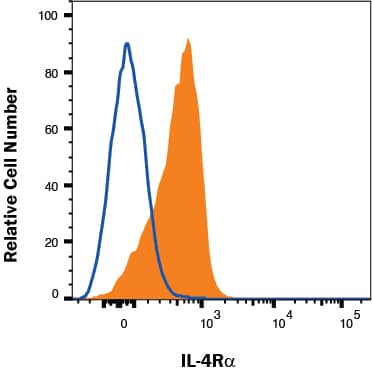Mouse IL-4 Antibody Summary
His23-Ser140
Accession # P07750
Customers also Viewed
Applications
Please Note: Optimal dilutions should be determined by each laboratory for each application. General Protocols are available in the Technical Information section on our website.
Scientific Data
 View Larger
View Larger
Cell Proliferation Induced by IL‑4 and Neutralization by Mouse IL‑4 Antibody. Recombinant Mouse IL‑4 (Catalog # 404-ML) stimulates proliferation in the HT‑2 mouse T cell line in a dose-dependent manner (orange line). Proliferation elicited by Recombinant Mouse IL‑4 (7.5 ng/mL) is neutralized (green line) by increasing concentrations of Goat Anti-Mouse IL‑4 Polyclonal Antibody (Catalog # AB-404-NA). The ND50 is typically 3-5 µg/mL.
Preparation and Storage
- 12 months from date of receipt, -20 to -70 °C as supplied.
- 1 month, 2 to 8 °C under sterile conditions after reconstitution.
- 6 months, -20 to -70 °C under sterile conditions after reconstitution.
Background: IL-4
Interleukin-4 (IL-4), also known as B cell-stimulatory factor-1, is a monomeric, approximately 13-18 kDa Th2 cytokine that shows pleiotropic effects during immune responses (1‑4). It is a glycosylated polypeptide that contains three intrachain disulfide bridges and adopts a bundled four alpha -helix structure (5). Mouse IL-4 is synthesized with a 24 amino acid (aa) signal sequence. Mature mouse IL-4 shares 39%, 39%, and 59% aa sequence identity with bovine, human, and rat IL-4, respectively. Human, mouse, and rat IL-4 are species-specific in their activities (6-8). IL-4 exerts its effects through two receptor complexes (9, 10). The type I receptor, which is expressed on hematopoietic cells, is a heterodimer of the ligand binding IL-4 R alpha and the common gamma chain (a shared subunit of the receptors for IL-2, -7, -9, -15, and -21). The type II receptor on nonhematopoietic cells consists of IL-4 R alpha and IL-13 R alpha 1. The type II receptor also transduces IL-13 mediated signals. IL-4 is primarily expressed by Th2-biased CD4+ T cells, mast cells, basophils, and eosinophils (1, 2). It promotes cell proliferation, survival, and immunoglobulin class switch to IgG1 and IgE in mouse B cells, acquisition of the Th2 phenotype by naïve CD4+ T cells, priming and chemotaxis of mast cells, eosinophils, and basophils, and the proliferation and activation of epithelial cells (11-14). IL-4 plays a dominant role in the development of allergic inflammation and asthma (13, 15).
- Benczik, M. and S.L. Gaffen (2004) Immunol. Invest. 33:109.
- Chomarat, P. and J. Banchereau (1998) Int. Rev. Immunol. 17:1.
- Lee, F. et al. (1986) Proc. Natl. Acad. Sci. USA 83:2061.
- Noma, Y. et al. (1986) Nature 319:640.
- Redfield, C. et al. (1991) Biochemistry 30:11029.
- Ramirez, F. et al. (1988) J. Immunol. Meth. 221:141.
- Leitenberg, D. and T.L. Feldbush (1988) Cell. Immunol. 111:451.
- Mosman, T.R. et al. (1987) J. Immunol. 138:1813.
- Mueller, T.D. et al. (2002) Biochim. Biophys. Acta 1592:237.
- Nelms, K. et al. (1999) Annu. Rev. Immunol. 17:701.
- Paludan, S.R. (1998) Scand. J. Immunol. 48:459.
- Corthay, A. (2006) Scand. J. Immunol. 64:93.
- Ryan, J.J. et al. (2007) Crit. Rev. Immunol. 27:15.
- Grone, A. (2002) Vet. Immunol. Immunopathol. 88:1.
- Rosenberg, H.F. et al. (2007) J. Allergy Clin. Immunol. 119:1303.
Product Datasheets
Citations for Mouse IL-4 Antibody
R&D Systems personnel manually curate a database that contains references using R&D Systems products. The data collected includes not only links to publications in PubMed, but also provides information about sample types, species, and experimental conditions.
4
Citations: Showing 1 - 4
Filter your results:
Filter by:
-
Progressively enhancing stemness of adoptively transferred T cells with PI3K? blockade improves metabolism and anti-tumor immunity
Authors: Rangel Rivera, GO;Dwyer, CJ;Knochelmann, HM;Smith, AS;Aksoy, BA;Cole, AC;Wyatt, MM;Kumaresan, S;Thaxton, JE;Lesinski, GB;Paulos, CM;
Cancer research
Species: Transgenic Mouse
Sample Types: Whole Cells
Applications: Bioassay -
The spleen is the site where mast cells are induced in the development of food allergy
Authors: S Toyoshima, E Wakamatsu, Y Ishida, Y Obata, Y Kurashima, H Kiyono, R Abe
Int. Immunol, 2017-01-01;0(0):.
Species: Mouse
Sample Types: Whole Cells
Applications: Neutralization -
The encephalitogenicity of T(H)17 cells is dependent on IL-1- and IL-23-induced production of the cytokine GM-CSF.
Authors: El-Behi M, Ciric B, Dai H
Nat. Immunol., 2011-04-24;12(6):568-75.
Species: Mouse
Sample Types: Whole Cells
Applications: Neutralization -
Suppression of autoimmune inflammation of the central nervous system by interleukin 10 secreted by interleukin 27-stimulated T cells.
Authors: Fitzgerald DC, Zhang GX, El-Behi M, Fonseca-Kelly Z, Li H, Yu S, Saris CJ, Gran B, Ciric B, Rostami A
Nat. Immunol., 2007-11-11;8(12):1372-9.
Species: Mouse
Sample Types: Whole Cells
Applications: Neutralization
FAQs
No product specific FAQs exist for this product, however you may
View all Antibody FAQsIsotype Controls
Reconstitution Buffers
Secondary Antibodies
Reviews for Mouse IL-4 Antibody
Average Rating: 5 (Based on 1 Review)
Have you used Mouse IL-4 Antibody?
Submit a review and receive an Amazon gift card.
$25/€18/£15/$25CAN/¥75 Yuan/¥2500 Yen for a review with an image
$10/€7/£6/$10 CAD/¥70 Yuan/¥1110 Yen for a review without an image
Filter by:

















